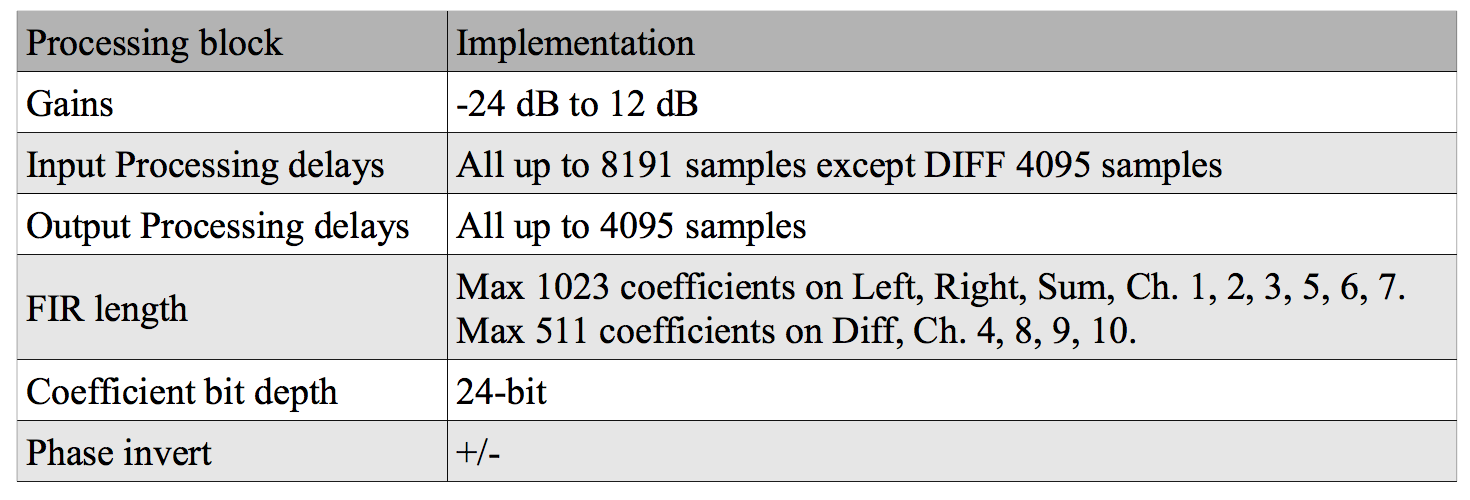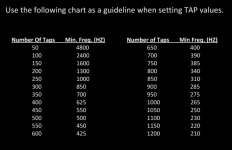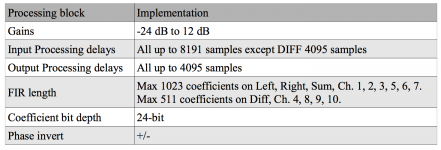LR swapped
Hi all,
yesterday i recieved 3 NOS Dac's and i connected them via i2s. Then i reroute the signal on the board to use the analog volume control. Everything is working well... except: when i reboot the najda left and right channel is swapped.
I need to switch between presets to make sure, that left and right channel is set correct. Simple reload doesn't help.
I am using these dac's:
DAC-NOS1 : Non Over-Sampling DAC, TDA1543T, I2S Input | eBay
Thanks and greetings
Christian
Hi all,
yesterday i recieved 3 NOS Dac's and i connected them via i2s. Then i reroute the signal on the board to use the analog volume control. Everything is working well... except: when i reboot the najda left and right channel is swapped.
I need to switch between presets to make sure, that left and right channel is set correct. Simple reload doesn't help.
I am using these dac's:
DAC-NOS1 : Non Over-Sampling DAC, TDA1543T, I2S Input | eBay
Thanks and greetings
Christian
Hi SpalmgreThere are many things to consider when setting up Najda. I hope this will help to understand the Core load.
The Core load can be seen at the Monitor screen when Najda is on line.
Core 0 and 1 can be loaded to prosess different parts of the setup. See my 3 way setup .
There is a risk that you overload Core 0 if you don't rout them as I have done.
Pairing helps you so that you can alter your EQ etc. on right and left channels at the same time.
I see all bass/treble are processed at the entry on the same core 0. Is this the reason than sometimes I have a Bass/Treble clip although I do not apply bass/treble corrections ?
BR
Jean-Louis
The core load has to do with processor capacity and this can be seen on the Monitor screen under Status / DSP Load core 0 and 1.
"Clip Warning" shows signal level that has to do with the gain structure. Meaning that if the signal level is to hi you get some indication. It is very typical that you have fast transient that the VU type indicator "Active Ins" don't show. See page 5 and 9.
Why do your Base/Treble indicate clipping is probably related to that you send a to hi signal level in to Najda from your signal source. Remember that the dynamic of different recordings can have very different level of "spikes".
It seams that also digital signals may be to hi. I use jRiver usbe to usb Najda in. I have restricted the digital volume level to 85%. Some ripped flac files seams to contain an average higher signal level depending on the recording, mixing and postprossessing.
On page 26 is more info about the Base/Treble Settings. You can disable this feature all together. This is explained in the text. There is however reference to fig 16 and I think this is wrong. I thin it is suppose to bee fig 21.
"Clip Warning" shows signal level that has to do with the gain structure. Meaning that if the signal level is to hi you get some indication. It is very typical that you have fast transient that the VU type indicator "Active Ins" don't show. See page 5 and 9.
Why do your Base/Treble indicate clipping is probably related to that you send a to hi signal level in to Najda from your signal source. Remember that the dynamic of different recordings can have very different level of "spikes".
It seams that also digital signals may be to hi. I use jRiver usbe to usb Najda in. I have restricted the digital volume level to 85%. Some ripped flac files seams to contain an average higher signal level depending on the recording, mixing and postprossessing.
On page 26 is more info about the Base/Treble Settings. You can disable this feature all together. This is explained in the text. There is however reference to fig 16 and I think this is wrong. I thin it is suppose to bee fig 21.
Support question:
My Najda developed a strange issue on only the left tweeter channel. It is hissing and sometimes making weird sounds like stati, crackling and slight beeps and high pitched noises. This comes in and out, and also is sporadic while I am adjusting the volume in the Najda app. Just one channel effected.
Anyone experience something like this?
Herman
My Najda developed a strange issue on only the left tweeter channel. It is hissing and sometimes making weird sounds like stati, crackling and slight beeps and high pitched noises. This comes in and out, and also is sporadic while I am adjusting the volume in the Najda app. Just one channel effected.
Anyone experience something like this?
Herman
Hi, I have a similar problem with digitally distorted sound, easily noticebale in voices. I turn off and turn on the unit and it goes away.
Sometimes it happens almost instantly, sometimes it takes time to happen.
I see it as a hardware bug in the DSP region.
It is happening when I use FIR filters.
Sometimes it happens almost instantly, sometimes it takes time to happen.
I see it as a hardware bug in the DSP region.
It is happening when I use FIR filters.
Hi is this system available for purchase any more?
Does the designer respond to support queries after buying?
I did buy my Najda just some months ago.
I have always got fast response when indicating that I want to buy. I did also have some issue during delivery and also after delivery and did get fast response and a nice conversation.
I chose Najda before MiniDSP (I have the basic 4 channel miniDSP and used it before) and some other competing DSP boards and solutions. I wanted a ready to go boxed unit as I already have too many projects. And I really want to learn to measure and set up DSP gear. My main interest is now with active speakers that are DSP "driven".
Najda is developed by a private person who has used a lot of his private time with the project. When years go by things happen in life and I can only presume that the lac of visible support on forums has to do with that the developers time is spent elsewhere. Maybe there is a family or something similar.
But I and probably the majority of Najda owners like to see the upgrade to the software that has been promised to us so many times. I think that the potential of the hardware has not been used to its full extent without some added features. Maybe when sales decline that it will be a driving force to give us a new software version.
Still trying to get my head around FIR filters. The number of taps one can devote to each channel seems to be a contentious issue. I understand more is better, especially for the lower frequencies. But I don't recall seeing anybody quote any actual numbers.
However, I found this guide while I was looking at a video on Xilica DSPs. Here's what they recommend when setting up filters on their boxes. I believe they have 1200 taps available on each output channel.
What do you guys think of these figures as a guide? Screen grab attached.
(Their chart only goes down to 210Hz. I guess in the subwoofer range you'd just be allocating the max no. of taps?)
However, I found this guide while I was looking at a video on Xilica DSPs. Here's what they recommend when setting up filters on their boxes. I believe they have 1200 taps available on each output channel.
What do you guys think of these figures as a guide? Screen grab attached.
(Their chart only goes down to 210Hz. I guess in the subwoofer range you'd just be allocating the max no. of taps?)
Attachments
But I and probably the majority of Najda owners like to see the upgrade to the software that has been promised to us so many times. I think that the potential of the hardware has not been used to its full extent without some added features. Maybe when sales decline that it will be a driving force to give us a new software version.
The number of taps one can devote to each channel seems to be a contentious issue.
There was a promise of using decimation to optimise the use of the onboard resources, but this software never materialised. A suggestion was made for Nick to make the hardware and software open source so that the community could pursue further development of it, but there is no response from Nick. I have noticed that he is selectively corresponding with his customers (apparently only the recent ones). I tried establishing contact with him not long ago, but got no response.
Besides the unfulfilled promise of the above functionality, there is the worrying occasional reports of crashes and/or unexplained corruption of configurations.
I wish that Nick could just release the IP. It would relieve him of this burden of unsatisfied customers.
Hi chriss0212,Hi all,
yesterday i recieved 3 NOS Dac's and i connected them via i2s. Then i reroute the signal on the board to use the analog volume control. Everything is working well... except: when i reboot the najda left and right channel is swapped.
I need to switch between presets to make sure, that left and right channel is set correct. Simple reload doesn't help.
I am using these dac's:
DAC-NOS1 : Non Over-Sampling DAC, TDA1543T, I2S Input | eBay
Thanks and greetings
Christian
There is a bug in Najda on I2S port output management, Nick says in the datasheet that Najda uses the format: left-centered for I2S outputs, (standard format in I2S) this to say that when the bus "L / RCK" is positive, it is the left channel that is present on the bus "audio data I2S".
But Najda uses only in reverse mode and the right track, something that the setting does in "port expansion".
There is a solution, turn on your PC with the Najda setup application and connect it to Najda via the USB port, start the connection, which is set everything is OK the left channels are in their place on the "I2S audio data", according to the setting of the "Extension port routing" file. You can disconnect and shut down your PC, Najda keeps the configuration, skip if you put Najda on standby, in case you have to start again even if you have memorized in Najda ....
I have the same problem on my 2 Najda connected via the I2S ports on the ESS9018 and ESS9028 DACs, I made measurements with my Tektronics MDO3014 I2S options on the Najda I2S buses to confirm the bug ....
Nick, here's a new little problem to correct!
Hello,
I want to use Acourate with my Najda for generate FIR files to:
- digital crossover
- linearizing each driver
- performing a room correction
Has anyone ever used Najda's input Acourate FIR files? Are they compatible? Is the number of tap in Najda sufficient for a 3-way system?
noun ouches
I want to use Acourate with my Najda for generate FIR files to:
- digital crossover
- linearizing each driver
- performing a room correction
Has anyone ever used Najda's input Acourate FIR files? Are they compatible? Is the number of tap in Najda sufficient for a 3-way system?
noun ouches
FIR taps in Najda are very limited, only 1023 on most channels. Most Acourate filters would be set at 65536.
It is the lowest frequencies that suffer the most as you need a lot of taps at low frequency to get an accurate slope match.

To get the most out of Acourate a computer running multichannel convolution is a better solution.
It is the lowest frequencies that suffer the most as you need a lot of taps at low frequency to get an accurate slope match.
To get the most out of Acourate a computer running multichannel convolution is a better solution.
Attachments
To get the most out of Acourate a computer running multichannel convolution is a better solution.
Do you know any pc digital audio interfaces that would accept optical / spidf inputs ,allow all dsp software-wise & routing and have 3 spidf outputs for external dacs?
Do you know any pc digital audio interfaces that would accept optical / spidf inputs ,allow all dsp software-wise & routing and have 3 spidf outputs for external dacs?
MOTU.com - Overview
I think this can
It's too bad Najda doesn't offer enough taps.
Indeed, the solution is really elegant and suits my needs very well.
I don't want a PC as a sound source, I'm looking for a dedicated hardware.
One solution could be to keep Najda for the medium/tweeter and treat the bass with a minisharc connected with I2S output on the Najda.
The OpenDRC 2x2 plugin offers 6144 taps per channel.
In this case, I would have to go through a 3-way I2S DAC and not through the Najda internal DAC.
This could work because I'm building a 3-way I2S DAC based on AK4490 and volume control with arduino.
Do you think it work well ? Or an another simpler solution could be implemented?
I don't find another DSP DIY solution with more taps.
nounouchet
Indeed, the solution is really elegant and suits my needs very well.
I don't want a PC as a sound source, I'm looking for a dedicated hardware.
One solution could be to keep Najda for the medium/tweeter and treat the bass with a minisharc connected with I2S output on the Najda.
The OpenDRC 2x2 plugin offers 6144 taps per channel.
In this case, I would have to go through a 3-way I2S DAC and not through the Najda internal DAC.
This could work because I'm building a 3-way I2S DAC based on AK4490 and volume control with arduino.
Do you think it work well ? Or an another simpler solution could be implemented?
I don't find another DSP DIY solution with more taps.
nounouchet
I'm building a 3-way I2S DAC based on AK4490 and volume control with arduino.
Hi Nounouchet
Interesting, could you give more informations ?
BR
Jean-Louis
It's too bad Najda doesn't offer enough taps.
Indeed, the solution is really elegant and suits my needs very well.
I don't want a PC as a sound source, I'm looking for a dedicated hardware.
One solution could be to keep Najda for the medium/tweeter and treat the bass with a minisharc connected with I2S output on the Najda.
The OpenDRC 2x2 plugin offers 6144 taps per channel.
In this case, I would have to go through a 3-way I2S DAC and not through the Najda internal DAC.
This could work because I'm building a 3-way I2S DAC based on AK4490 and volume control with arduino.
Do you think it work well ? Or an another simpler solution could be implemented?
I don't find another DSP DIY solution with more taps.
nounouchet
All the hardware solutions available with FIR capabilities are limited in processing power and don't really have enough taps to do what you want without compromise.
I think the better method is to use IIR crossovers and EQ to get you close to what you want and then use FIR for a final overall EQ and time correction.
The DAC in the Najda is very good and the analogue volume control isn't something I would want to lose. Leave the Najda on the end of the chain and put the Open DRC / minisharc or whatever in front of the Najda and connected digitally to process the incoming stereo signal. It doesn't matter which order the processing goes in as long as the measurement is taken with the same setup. Try that first and see if it works for you.
I think the better method is to use IIR crossovers and EQ to get you close to what you want and then use FIR for a final overall EQ and time correction.
I really like this concept, but how does one go about creating a FIR filter to correct phase only? I’m assuming something like FIR Designer would be the ticket?
- Home
- Source & Line
- Digital Line Level
- DSP Xover project (part 2)

